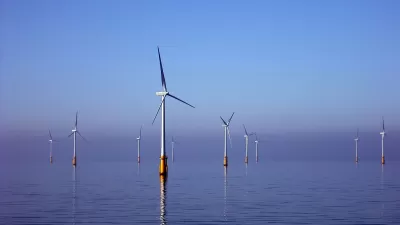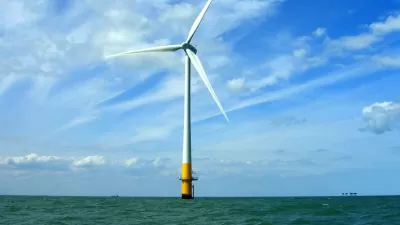Unique geography and high costs have stymied offshore wind energy production in California, but new incentives and innovations could soon make it more accessible.

Writing in the OC Register, Brooke Staggs describes the potential of offshore wind energy in the United States and, specifically, California, where offshore wind production has been held back by geography, among other factors.
“But with wind power now seen as key to helping both California and the U.S. meet their clean energy goals, new state and federal programs are focused on helping us push past those obstacles and become a leader in the offshore wind front,” Staggs writes. “In August, the California Energy Commission set goals of installing offshore wind projects that could generate 2,000 to 5,000 megawatts by 2030 and 25,000 megawatts by 2045. That would be enough electricity to power 3.75 million homes over the next seven years and 25 million homes by mid-century.”
The article describes the challenges of installing offshore wind turbines in the deep waters off the California coast, which require floating installations rather than turbines anchored to the sea floor, making it more expensive. California’s situation is complicated by the vast amounts of coastline controlled by the Department of Defense, which are currently off limits to wind energy projects. But with technology rapidly improving and incentives from the federal government adding a boost, offshore wind energy along the West Coast could soon be a reality. “[T]wo areas off the coast of Humboldt and three areas near Morro Bay, totalling a combined 373,000 acres, have so far been identified as prime floating wind farm locations. If fully developed, the projects could generate 4,500 megawatts of electricity, or enough power for 1.5 million homes.”
FULL STORY: Floating wind turbines off California coast soon could boost power grid

Alabama: Trump Terminates Settlements for Black Communities Harmed By Raw Sewage
Trump deemed the landmark civil rights agreement “illegal DEI and environmental justice policy.”

Study: Maui’s Plan to Convert Vacation Rentals to Long-Term Housing Could Cause Nearly $1 Billion Economic Loss
The plan would reduce visitor accommodation by 25% resulting in 1,900 jobs lost.

Why Should We Subsidize Public Transportation?
Many public transit agencies face financial stress due to rising costs, declining fare revenue, and declining subsidies. Transit advocates must provide a strong business case for increasing public transit funding.

Paris Bike Boom Leads to Steep Drop in Air Pollution
The French city’s air quality has improved dramatically in the past 20 years, coinciding with a growth in cycling.

Why Housing Costs More to Build in California Than in Texas
Hard costs like labor and materials combined with ‘soft’ costs such as permitting make building in the San Francisco Bay Area almost three times as costly as in Texas cities.

San Diego County Sees a Rise in Urban Coyotes
San Diego County experiences a rise in urban coyotes, as sightings become prevalent throughout its urban neighbourhoods and surrounding areas.
Urban Design for Planners 1: Software Tools
This six-course series explores essential urban design concepts using open source software and equips planners with the tools they need to participate fully in the urban design process.
Planning for Universal Design
Learn the tools for implementing Universal Design in planning regulations.
Smith Gee Studio
Alamo Area Metropolitan Planning Organization
City of Santa Clarita
Institute for Housing and Urban Development Studies (IHS)
City of Grandview
Harvard GSD Executive Education
Toledo-Lucas County Plan Commissions
Salt Lake City
NYU Wagner Graduate School of Public Service





























